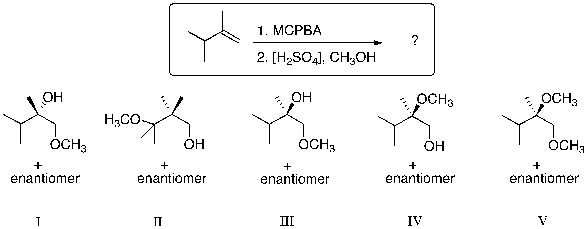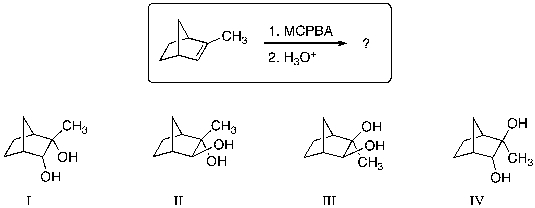A) I
B) II
C) III
D) IV
E) V
Correct Answer

verified
Correct Answer
verified
Multiple Choice
For the reaction sequence below, identify the expected major products. 
A) ![]()
B) ![]()
C) ![]()
D) ![]()
Correct Answer

verified
Correct Answer
verified
Multiple Choice
How many moles of hydrogen (H2) are required to completely reduce 1 mole of cis-2,3,3-trimethylhepta-1,5-diene?
A) 02
B) 1
C) 2
D) 3
E) 4
Correct Answer

verified
Correct Answer
verified
Essay
Identify the structure(s) of the expected major organic product(s) of the following reaction. Draw the products in the expected chair conformations and include regiochemical and/or stereochemical details as needed. 
Correct Answer

verified
 The reaction takes place with Markovnik...
The reaction takes place with Markovnik...View Answer
Show Answer
Correct Answer
verified
View Answer
Multiple Choice
Which reagents are most likely to accomplish the transformation shown below? 
A) 1. BH3∙THF / 2. HO-, H2O2, H2O
B) H+, H2O
C) 1. Hg(OAc) 2, H2O, THF / 2. NaBH4
D) 1. Hg(OAc) 2, CH3OH / 2. NaBH4
E) NaOH, H2O
Correct Answer

verified
Correct Answer
verified
Multiple Choice
Which of the structures shown depicts the most stable carbocation intermediate formed in the hydrohalogenation reaction shown? 

A) I
B) II
C) III
D) IV
E) V
Correct Answer

verified
Correct Answer
verified
Multiple Choice
Treatment of 1,2-dimethylcyclopentene with OsO4, followed by aqueous NaHSO3, produces which of the following: 
A) I
B) II
C) III
D) IV
E) V
Correct Answer

verified
Correct Answer
verified
Multiple Choice
How many carbonyl groups are generated upon treatment of the molecule below with ozone, followed by zinc metal and water? 
A) 1
B) 2
C) 3
D) 4
E) 8
Correct Answer

verified
Correct Answer
verified
Multiple Choice
What is the expected product for the hydrogenation of an alkene?
A) dihaloalkane
B) alkane
C) haloalkane
D) alcohol
E) ether
Correct Answer

verified
Correct Answer
verified
Multiple Choice
Wilkinson's catalyst accomplishes which of the listed molecular transformations?
A) syn addition of H2 to an alkene
B) anti addition of H2 to an alkene
C) syn dihydroxylation of an alkene
D) anti dihydroxylation of an alkene
E) oxidative cleavage of an alkene
Correct Answer

verified
Correct Answer
verified
Essay
Starting with (2R,3R)-2-chloro-3,4-dimethylpentane, a) draw the expected major product for each step, including regiochemical and stereochemical details when needed. In addition, b) briefly explain the mechanistic rationale for each transformation. i. t-BuOK/t-BuOH, heat ii. MCPBA/CH2Cl2 iii. H3O+
Correct Answer

verified
 Hofmann elimination occurs upon heating...
Hofmann elimination occurs upon heating...View Answer
Show Answer
Correct Answer
verified
View Answer
Essay
Provide the structure(s) of the expected major organic product(s) generated upon completion of the following reaction scheme: 
Correct Answer

verified
Correct Answer
verified
Short Answer
The rule that correctly predicts the regiochemistry of most ionic additions to alkenes is named after which chemist?
Correct Answer

verified
Correct Answer
verified
Multiple Choice
What is the major product for the following reaction sequence? 
A) I
B) II
C) III
D) IV
E) V
Correct Answer

verified
Correct Answer
verified
Multiple Choice
Which of the reagents below are expected to convert cyclopentene into cyclopentane?
A) H2 and Ni
B) H2O
C) Heat
D) Zn, H3O+
E) Light
Correct Answer

verified
Correct Answer
verified
Multiple Choice
The regioselectivity and stereospecificity in hydrohalogenation of an alkene is best described as:
A) Markovnikov orientation with syn-addition
B) Markovnikov orientation with anti-addition
C) anti-Markovnikov orientation with syn-addition
D) anti-Markovnikov orientation with anti-addition
E) Markovnikov orientation with both syn- and anti-addition
Correct Answer

verified
Correct Answer
verified
Multiple Choice
For the complete reduction of 1 mole of (3E,5E) -hepta-1,3,5-triene with H2 using a Pd catalyst, how many moles of H2 are consumed?
A) 1
B) 2
C) 3
D) 4
E) 5
Correct Answer

verified
Correct Answer
verified
Multiple Choice
What are the major products for the following reaction sequence? 
A) I and II
B) II and III
C) III and IV
D) I and III
E) II and IV
Correct Answer

verified
Correct Answer
verified
Essay
Provide the structure(s) of the expected major organic product(s) generated upon completion of the following reaction scheme: 
Correct Answer

verified
Correct Answer
verified
Multiple Choice
What is the expected major product for the following reaction? 
A) ![]()
B) ![]()
C) ![]()
D) ![]()
E) ![]()
Correct Answer

verified
Correct Answer
verified
Showing 121 - 140 of 148
Related Exams